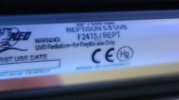VhaporKingT
New Member
Hey all,
The Problem: Recently I started noticing white areas at the corners of the scutes and wanted your guys' input on whether it is an indicator I might need to make a change in his care/environment.
Note:
I ask that if you respond, please be kind, don't speak in absolutes (having positive outcomes with your preferred style of husbandry doesn't make other styles inviable), and please know that I am willing to take constructive criticism and make changes in order to help my little guy get the healthy long life he deserves. I am a new tortoise owner and recognize that leopard tortoises are not generally great/easy starter tortoises, but I am up for the challenge and did research before adopting and have trying my best to continue to educate myself as questions arose over the past month since adopting my hatchling.
Care Info:
Tortoise Type: Leopard Tortoise
Adoption: Adopted October 23rd ( was a 40g hatchling) at a local reptile convention. I live in the PNW and it is pretty cold at this time of year (close to 30f in the evening) so he hasn't gotten any real outside time just yet, but I have a big back yard with plenty of grass and weeds that are never touched with fertilizers or pesticides, so I wanna give him some supervised adventure time this summer.
Enclosure Type: 70 gallon glass tank with front-opening doors and a wire mesh top (I know, I know, as you'll see below I've covered the enclosure on top and sides with tin foil to keep moisture and heat inside.
Substrate: Coco Choir and Play Sand Mixture (I'm aware sand isn't ideal and will likely be replacing the substrate next week when I have some time).
Heating: I have a ceramic heating element connected to a thermostat hanging (sensor is placed tortoise-hight near his moss-hide since i'm most worried about temp being kept up in the night time) left of center in the tank, closer to the cooler side where his hide is located to keep that area at a minimum of 80 degrees at all times. On the basking side of the enclosure I have a basking rock area that sits around 95-99 degrees during the day. I check the temps regularly with a temp gun.
Humidity/Moisture: I've got a water bowl I make sure to clean out once a day when it gets substrate in it. I give him daily 30 minute baths in warm water and he usually gets his poops out at this point if he's got any, which always seem pretty solid and healthy. I was having issues keeping the terrarium humid for the first several weeks of having him and it would often drop to the 40%-50% range despite my misting it multiple times a day (I know it was largely due to sand not being great at holding moisture). But last week I got a humidifier that I can have run a 60secs on/60secs off continuous cycle and adjust the humidity intensity. With this addition I've been able to keep his enclosure at a pretty consistent 75-95% humidity.
Light: Underneath the foil on top of the wire mesh top I have a UVA/UVB strip light that spans the entire width of the enclosure. Both the UV light strip and the basking lamp are on a timer that turns on and off automatically on a 12-hour cycle (On: 7am-7pm). Heating element with thermostat stays on at all times obvs😉.
Food: I've been giving him 80% grass ( Clippings from the backyard plus some wheat grass mixed in) and about 20% other things I try to rotate through (Collard greens, red/regular kale, dandelion greens, bell pepper chunks, occasional [non-butter] lettuce). I also will sprinkle about a large pinch of calcium + D powder onto his food about 4 times a week. I do think I may be giving him a tad too much food sometimes though because he usually doesn't eat it all, I'd say he eats about 85% of it. I try and shoot for a shells-worth (based on his shell) but it will often end up more of a "heaping shells-worth" once I've put the grasses and everything else together.
He's still pretty shy and tends to still nap a decent amount, but he definitely still gets some walking around in during the day and seems to be doing ok happiness-wise, though he's still not sure what to think about me and is not a huge fan of bath time. My main theory for the white areas is shell growth and I may be over feeding him, but I wanted to check in with you guys and make sure it's not shell rot or some other issue before I took him to a vet unnecessarily. I'm really trying hard to do right by him, and though I know that glass enclosures aren't ideal, I feel like I've been able to get to a place with my thermostat and humidifier where I can keep the temp and moisture in a good place for him, so comments saying to throw my enclosure away or that I'm a abusive owner for not knowing everything I could possibly know before getting a leopard tortoise are not helpful or why I am seeking advice here. Obviously though, if you think the glass enclosure is the sole reason for the white areas feel free to explain and I'd be open to exploring a more tortoise-table style of enclosure.
Enclosure:
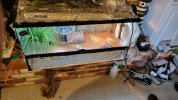
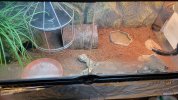
My Tortoise (Jason): Some calcium powder got onto his shell this morning, so ignore the white specs, I'm asking about the white areas where the corners of his scute meet each other.

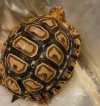
What his shell looked like when I first got him:
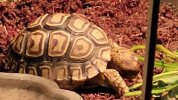
Thank you so much for your help! Please let me know if this is just normal growth or a sign that I need to modify something about the way I'm caring for him.
The Problem: Recently I started noticing white areas at the corners of the scutes and wanted your guys' input on whether it is an indicator I might need to make a change in his care/environment.
Note:
I ask that if you respond, please be kind, don't speak in absolutes (having positive outcomes with your preferred style of husbandry doesn't make other styles inviable), and please know that I am willing to take constructive criticism and make changes in order to help my little guy get the healthy long life he deserves. I am a new tortoise owner and recognize that leopard tortoises are not generally great/easy starter tortoises, but I am up for the challenge and did research before adopting and have trying my best to continue to educate myself as questions arose over the past month since adopting my hatchling.
Care Info:
Tortoise Type: Leopard Tortoise
Adoption: Adopted October 23rd ( was a 40g hatchling) at a local reptile convention. I live in the PNW and it is pretty cold at this time of year (close to 30f in the evening) so he hasn't gotten any real outside time just yet, but I have a big back yard with plenty of grass and weeds that are never touched with fertilizers or pesticides, so I wanna give him some supervised adventure time this summer.
Enclosure Type: 70 gallon glass tank with front-opening doors and a wire mesh top (I know, I know, as you'll see below I've covered the enclosure on top and sides with tin foil to keep moisture and heat inside.
Substrate: Coco Choir and Play Sand Mixture (I'm aware sand isn't ideal and will likely be replacing the substrate next week when I have some time).
Heating: I have a ceramic heating element connected to a thermostat hanging (sensor is placed tortoise-hight near his moss-hide since i'm most worried about temp being kept up in the night time) left of center in the tank, closer to the cooler side where his hide is located to keep that area at a minimum of 80 degrees at all times. On the basking side of the enclosure I have a basking rock area that sits around 95-99 degrees during the day. I check the temps regularly with a temp gun.
Humidity/Moisture: I've got a water bowl I make sure to clean out once a day when it gets substrate in it. I give him daily 30 minute baths in warm water and he usually gets his poops out at this point if he's got any, which always seem pretty solid and healthy. I was having issues keeping the terrarium humid for the first several weeks of having him and it would often drop to the 40%-50% range despite my misting it multiple times a day (I know it was largely due to sand not being great at holding moisture). But last week I got a humidifier that I can have run a 60secs on/60secs off continuous cycle and adjust the humidity intensity. With this addition I've been able to keep his enclosure at a pretty consistent 75-95% humidity.
Light: Underneath the foil on top of the wire mesh top I have a UVA/UVB strip light that spans the entire width of the enclosure. Both the UV light strip and the basking lamp are on a timer that turns on and off automatically on a 12-hour cycle (On: 7am-7pm). Heating element with thermostat stays on at all times obvs😉.
Food: I've been giving him 80% grass ( Clippings from the backyard plus some wheat grass mixed in) and about 20% other things I try to rotate through (Collard greens, red/regular kale, dandelion greens, bell pepper chunks, occasional [non-butter] lettuce). I also will sprinkle about a large pinch of calcium + D powder onto his food about 4 times a week. I do think I may be giving him a tad too much food sometimes though because he usually doesn't eat it all, I'd say he eats about 85% of it. I try and shoot for a shells-worth (based on his shell) but it will often end up more of a "heaping shells-worth" once I've put the grasses and everything else together.
He's still pretty shy and tends to still nap a decent amount, but he definitely still gets some walking around in during the day and seems to be doing ok happiness-wise, though he's still not sure what to think about me and is not a huge fan of bath time. My main theory for the white areas is shell growth and I may be over feeding him, but I wanted to check in with you guys and make sure it's not shell rot or some other issue before I took him to a vet unnecessarily. I'm really trying hard to do right by him, and though I know that glass enclosures aren't ideal, I feel like I've been able to get to a place with my thermostat and humidifier where I can keep the temp and moisture in a good place for him, so comments saying to throw my enclosure away or that I'm a abusive owner for not knowing everything I could possibly know before getting a leopard tortoise are not helpful or why I am seeking advice here. Obviously though, if you think the glass enclosure is the sole reason for the white areas feel free to explain and I'd be open to exploring a more tortoise-table style of enclosure.
Enclosure:


My Tortoise (Jason): Some calcium powder got onto his shell this morning, so ignore the white specs, I'm asking about the white areas where the corners of his scute meet each other.


What his shell looked like when I first got him:

Thank you so much for your help! Please let me know if this is just normal growth or a sign that I need to modify something about the way I'm caring for him.

